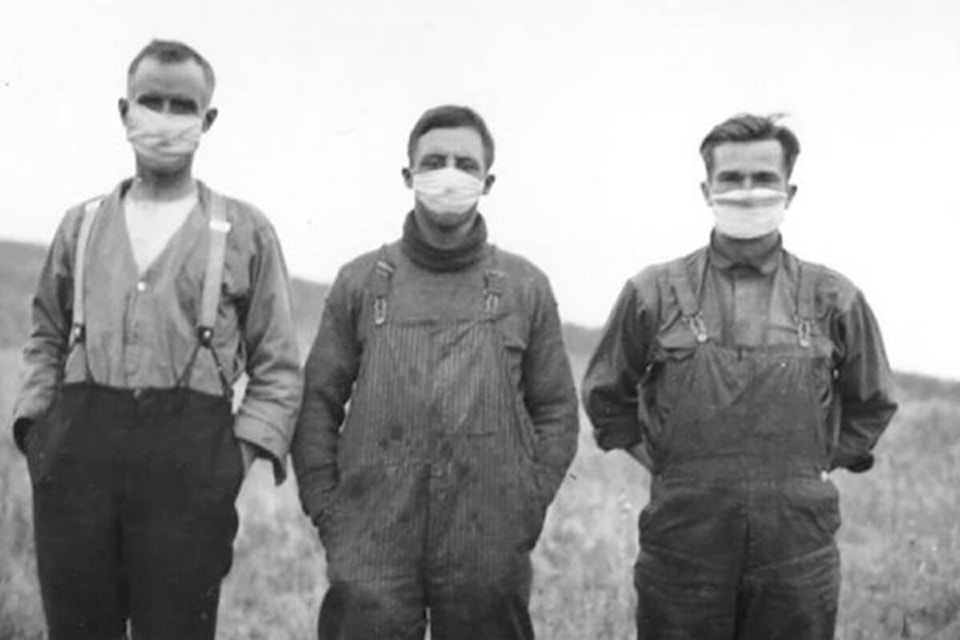Since March of 2020, we have been living under the shadow of COVID-19. We have more information and media coverage than we need. We often feel that the world is a surreal place, with new worries. But it isn’t.
In the fall of 1918, as the First World War was drawing to a close, the world was suddenly under attack from an enemy that was far more dangerous. The enemy was Spanish influenza. Spain was the first country, in May of 1918, to report the presence of a deadly virus. In fact, the virus had erupted in Canton, China, as early as February. By April it was spreading across Europe and Britain.
The Spanish Flu arrived in Canada aboard troopships in the summer of 1918. By September, it had travelled west and into remote outposts in the Maritimes onboard supply boats. Medical facilities everywhere were completely overwhelmed. Across the country, rural areas were especially hard hit. Often there were no medical professionals within a hundred miles. People did what they could for their families and neighbours, using what little medical knowledge they had.
The impact of the flu on small towns like Drumheller was drastic. With the loss of its doctor, the town was quarantined. The school was turned into a temporary hospital. A young teacher with limited nursing experience soon found herself caring for 20 coal miners. By the end of a month, she and another girl had over 100 patients.
In response to the fast-moving wave, most provinces closed all public venues from schools to any social gatherings. Business hours were restricted and retired or unemployed teachers and civil servants were recruited to help with the sick. Aid was especially slow in reaching the North where provincial police and RCMP were dispatched to assist in nursing the sick, hunting and fishing for food, and caring for sled dogs.
Vaccinations tried through 1918-19 against the disease were not successful as the virus itself was not identified until 1933. In the meantime, Canadians tried home remedies. Some people tied camphor bags or salted herring around their necks. Some sprinkled sulphur on their shoes to ward off germs. Cinnamon, bran, garlic and onion cures were tried. Mustard plasters, herbal poultices, shots of liquor were tried. Alcohol was a tricky option. In 1917, Canada had adopted prohibition as a wartime measure. The epidemic brought calls for its repeal “for medicinal purposes only.”
Well-known companies used the flu to boost their sales. The CCM company’s ads touted bicycles as a healthy alternative to “over-crowded streetcars with their danger of contagion.” Patent medicines such as Dr. Chase’s Menthol Bag, Syrup of Linseed and Turpentine, and Riga Purgative Waters were advertised in Maclean’s and the Canadian Home Journal. Horlick’s Malted Milk and Vaseline were promoted as anti-influenza measures.
By far the most popular defence against flu germs was masks. Every household received a flyer on how to make a mask. A piece of cheesecloth, 8x16 inches, was to be folded and a cord about 10 inches long was to be tied at each corner. Many old photos show a variety of people wearing masks, such as bank employees, women walking past shops, Winnipeg Free Press newspaper carriers, three farmers on a prairie field. Alberta was one of the first provinces to pass a mask law. Individual towns passed bylaws levying fines of $1 to $50 for violations.
The Spanish Flu continued to move into every corner of the country in three waves. It gradually petered out in the mid-1920s. It had struck one-quarter of Canada’s eight millon people and taken 50,000. The cost in personal terms was very high with the loss of loved ones and wage earners. Local relief costs had soared and businesses had faltered.
During the first year of the epidemic, each province had tried to handle its own medical and financial issues but had been caught without a plan for such a disaster. Federal politicians realized that there had to be a health plan for the whole country. In the fall of 1919, a federal Department of Health was set up.
We do have a pandemic and there are many similarities. But we have a worldwide commitment to get us through this. Of course, there are conflicting theories and disagreements but positive thoughts and caring for others are what we do best. Be kind, be calm, be safe.
newsroom@100milefreepress.net
Like us on Facebook and follow us on Twitter.
